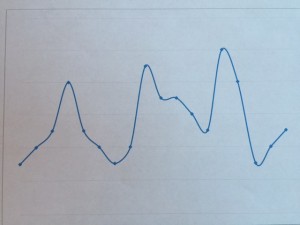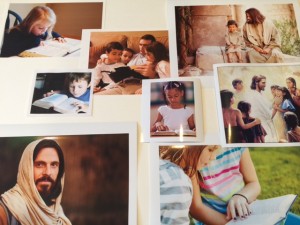A melody is something you can’t touch or see, you can only hear! How do you help a concrete thinking child to visualize a melody?
Try a melody map!
Below is a melody map for If I Listen With My Heart. You can print it, enlarge it so the children can see (or just free hand it onto some poster boards), then use it for a verse of this song (either 1, 2, or 3). I will use it with the younger children using pictures for verse one. I will use it for the older children with verse two and key words of that verse.
Click here for If I listen with my heart melody map (4 sections).
How do you use a melody map? This is how I use it with older children (see younger children below).
Older Children:
Put the melody maps out of order at the front of the room. (Hint: be careful not to put them upside down<grin>.)
- Engage the children: Ask: What do you see? What do you notice? Receive the children’s answers.
- Engage and Sing: Ask… What do these lines have to do with this song. Sing the song. Receive the children’s answers. Hint: you are not looking for the right answer (the lines represent how high or low the melody goes), but you’re looking for what the children think the lines represent… thus every answer is valid because it is their thoughts.
- Tell, Engage, and Sing: Tell the children you actually made these maps to show how high or low the melody goes in the song BUT the four posters are not in the right order. Ask… which of these is the first line of the song? Sing the song, at least the first line.
- Engage and Sing: Ask the children to help you figure out the order for all of the posters. Sing. Receive their answers. Point to the dots as you sing and check out the children’s answers.
The beauty of this activity is that the children get to hear the song over and over again while they are putting the posters in order. They don’t recognize how many times they are hearing it because they are concentrating on putting the symbols (the lines) in order.
Extender Activity:
Make word cards of the major words of the verse you are teaching. For example, I am using this with the 2nd verse of the song.
Here are the words I will use: hear, prophet, speak, things, Christ, say, here, earth, talk, today, prophet, how, live, peace, listen, heart, hear, Savior’s, voice.
I put these word cards up at the front of the room out of order. I tap a child on the shoulder and ask him to put the word on the map where it goes in the song as I sing. I tap another child on the shoulder, and continue to tap until all the words are chosen and put on the map. If a child needs help, I will emphasize a word and point as I sing.
Younger Children:
Put the melody maps at the front of the room IN ORDER. (That is different than you would do for the older children.)
Prepare 8 or so pictures that have to do with the words of the verse you are going to teach. Because I am using the melody map with the younger children for the first verse, I chose pictures of little children with Jesus, and pictures of children reading the scriptures. Put the pictures up at the front of the room.
- Engage the children: Ask: What do you see? What do you notice? Receive the children’s answers.
- Engage and Sing: Ask… What do these lines have to do with this song? What do these pictures have to do with the song? Sing the song. Receive the children’s answers. Hint: you are not looking for the right answer (the lines represent how high or low the melody goes), but you’re looking for what the children think the lines represent… thus every answer is valid because it is their thoughts.
- Sing the song again running your finger along the line of the correct map as you sing.
- Tap a child on the shoulder and ask her to choose a picture and put it up around the melody map while you sing. Continue tapping another child and another child on the shoulder as you sing until all the pictures are up by the melody map.
Extender: Ask the children to memorize the pictures on their inside chalkboard. Have them close their eyes while you sing the first two lines of the song and take away two of the pictures. Ask the children which pictures you took away and what the colors were. Have them close their eyes again and sing the next two lines of the song while you take away two more pictures. Again ask what the pictures were that you took. Repeat singing and taking pictures until you have sung the whole song. Ask the children to sing the song with you while you have children help you (who didn’t originally put up pictures) by tapping them on the shoulder to put all the pictures back up (one picture per child) as the children sing.



Bonnie Lythgoe
I think this idea would be such a great one to try with my (combined) Primary, but I have never used a melody map before! I’m having a little bit of a hard time figuring out where each major word falls. Does this start at the first word, and end with “…Savior’s voice?” What words fall on the peaks? Thank you!
Bonnie Lythgoe
I downloaded, and saw all 4 pages… mystery solved! I was having a hard time figuring out how it all fit in that 1st page! Thank you for your lesson plans!
Sharla Dance
yea!
Kaylene
I assume with the younger kids, that it doesn’t matter what order they put the pictures? (around the map?)
Sharla Dance
Kaylene, it doesn’t matter, especially for the younger ones. If you have a 6 or 7 year old, you could notice if they try to match it to the words.
sonrisa
if there is any way you could explain in detail what words go in what spot that would help me tremendously. I teach music on Sundays but have no music background whatsoever so all this is a stretch for me but I love how you teach music!
Thanks
Sharla Dance
Each dot is a note in the music. If has two notes, I, had, been, a has two notes, little has two notes, child. When you sing the song and point to the dots as you sing, you will see how the dots go up when the melody goes up, and the dots go down when the melody goes down. Good for you for trying new things and going for it. I’m proud of you.
Angela
Thank you so much! I am doing this today. I have been a chorister for almost 3 years and have never seen a melody map as a way of teaching a song! I am very musical and LOVE this idea! Thanks again!!!!!
Melissa Kershaw
Is this better for learning or reviewing a song?
Sharla Dance
You can use it for both learning or reviewing a song, especially if you mix the maps up and they try to figure out which one comes first.
Alyse
Do you see a good way to do this in a smaller combined primary? I love challenging my older children (fewer of them, but all very bright), but I have to be able to do it while keeping the younger children engaged as well… It’s a challenge to do both, but I dislike skipping the challenges for the older children just because it’s easier. Any input?
Sharla Dance
Dear Alyse, If I have both age levels at once, I will often do one of these things: 1. Challenge the older children with a puzzle or something at their level and have the younger children do a movement while singing. The older children need to finish the challenge by the time the younger have sung and moved through the song twice. 2. Assign an older child to a younger child as their helper and they do a partner thing together (more than a younger child could normal do, but now he or she has a buddy). 3. Have the younger children color some “visuals” for the song, while you do an activity with the older children.
There is no perfect solution when you have both ages together, but maybe that will help start some other ideas for you. Take care, Sharla
Jen Bayles
I love this!! I think that as an extender, I will pass out scarves and encourage the kids to draw the melody in the air with their scarves while we sing. I think they’ll enjoy the visual of the melody map along with using their body to match it. You’re the best, Sharla! <3 <3
Sharla Dance
Dear Jen, You have very lucky children in your Primary. Thank you for thinking of extenders! Sharla
Michelle R.
I’m over in England teaching music time and this is new to me. I LOVE it!! Thank you for taking the time to share your love of music and your great talent. The kids are going to really enjoy this song!
Sharla Dance
Dear Michelle,
Welcome! I’m hoping that the children will blossom under your care! Take care, Sharla
Joy
Have I mentioned before how very much I appreciate you Sharla, and all you do to help the hundreds of children you have never met to love and learn music through those of us you share with? I want to be like you when I grow up. Thanks you to all who share their comments and expertise as well.
Sharla Dance
Dear Joy, Thank you. I’m just an instrument. I’m pretty weak, but amazing things happen when we try to serve Him. Thank you for your kind words.
Louisa Odonkor
Is it important to teach music separately or together.Does it affect them in anyway?
Sharla Dance
Dear Louisa, Do you mean teaching the words separately from the music? Or perhaps teaching verses separately from each other?